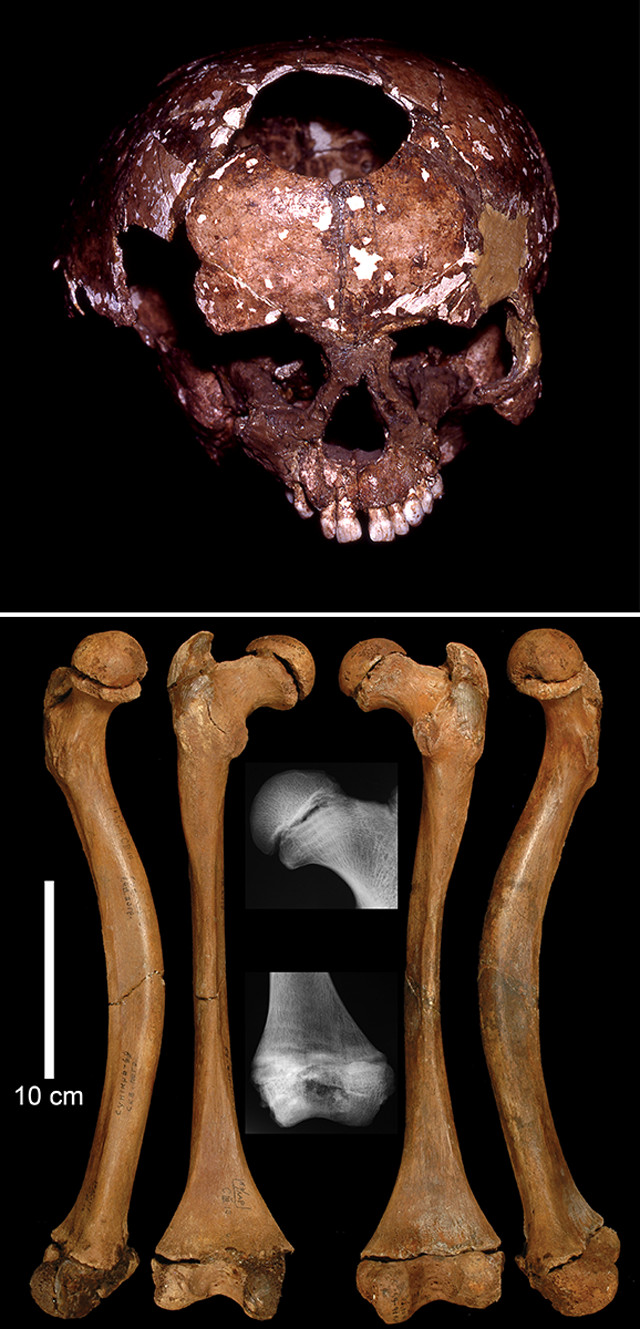
by Mary Caperton Morton Wednesday, February 13, 2019

The malformed skull of a 2- to 3-year-old Pleistocene hominid (top) found in France shows signs of hydrocephalus, a swelling of the braincase due to excess fluid in the skull. The hole in the top of the skull is thought to have been cut postmortem. Abnormally bowed femurs (bottom) in the fossil skeleton of a 10-year-old boy found at the Sunghir site in Russia may have been caused by chronic nutritional stress or an inherited disorder. Credit: both: Erik Trinkaus/PNAS.
The Pleistocene was a hard time for hominids. Homo fossils from this period, when humans evolved and expanded from Africa and across Eurasia, are riddled with an unusual number of skeletal abnormalities. Swollen braincases, bowed femurs, twisted long bones, pronounced dwarfism and malformed teeth are just a few of the unusual skeletal features found in many Pleistocene hominid fossils. A new statistical study has confirmed that these anomalies occur at higher-than-expected rates in the Pleistocene fossil record. But whether this elevated incidence was mainly caused by nutritional stress or inbreeding, or if it’s an artifact of preservational bias, is unknown.
There are relatively few specimens in the hominid fossil record from between 2.5 million and 11,700 years ago, but the large number of these that show some form of pathology is statistically significant, says Erik Trinkaus, a paleoanthropologist at the University of Washington and lead author of the new study, published in Proceedings of the National Academy of Sciences.
“I had been noticing these [examples of skeletal abnormalities] for some time, and since they have bearing on the ultimate question — What was life like for these people? — I decided to start pulling them all together,” Trinkaus says. Most of the 75 distinct abnormalities spread among the 66 specimens assembled for the new study, had been previously described by Trinkaus and others as examples of unusual pathologies. The fossils, mainly from the last 200,000 years, represent several coexisting species of Homo — including Homo sapiens, Homo floresiensis and Neanderthals — and were found throughout the Middle East, Europe and Asia.
Some of the observed skeletal abnormalities, such as malformed teeth and bowed long bones, can be attributed to nutritional stress, while others were likely present at birth, including one case of hydrocephalus, which involves a swollen braincase due to extra fluid and pressure in the skull. About two-thirds of the deformities reflect ailments seen in modern humans, with about half of these being moderately common (like malformed teeth) while others are exceedingly rare (like excessively bowed long bones) or are not known in modern times (including several cases of unusual cranial deformation). Based on modern incidence rates of similar disorders, Trinkaus calculated the probability of so many ancient abnormalities occurring in a limited sample set by chance and found it to be “vanishingly small,” he says.
The study suggests that the incidence of birth defects in the Pleistocene may have been higher than expected due to relatively limited gene pools and the isolated nature of hunter-gatherer tribes. “Inbreeding is the obvious answer, but it does not explain all the abnormalities,” Trinkaus says. Some types of birth defects may also be attributed to nutritional stress in expectant mothers.
“These kinds of big-picture studies can shine a light on what life was like in the Pleistocene; and it’s clear it wasn’t easy by any means,” says Clark Larsen, a bioarchaeologist at Ohio State University who wasn’t involved in the new study. “But it’s also clear that these hominids were extremely adaptable and that they had social structures that supported their fellow man in the face of adversity.”
Most of the fossils considered in the new study came from young adults, suggesting these individuals were able to live for some time despite their disabilities. “In several instances, it’s doubtful that a person could have survived without some kind of support,” such as someone else providing him or her with food, shelter or protection, Larsen says.
Social support systems within early human communities may also point toward a source of preservational bias favoring skeletons from individuals with unique or distinctive physical features, Larsen says. Previous studies on notably elaborate grave sites, such as the Sunghir site in Russia, have suggested that people with disabilities were sometimes given special burials that made their remains more likely to be preserved and thus later recovered by archaeologists. “It’s tantalizing,” Larsen says, “to think about how social circumstances may have contributed to longer life spans for individuals who were disabled.”
© 2008-2021. All rights reserved. Any copying, redistribution or retransmission of any of the contents of this service without the expressed written permission of the American Geosciences Institute is expressly prohibited. Click here for all copyright requests.